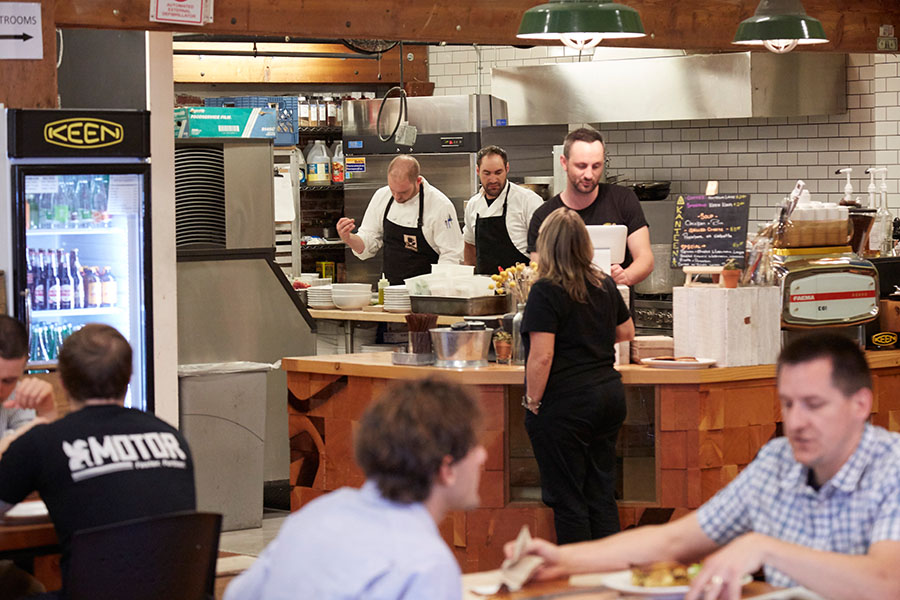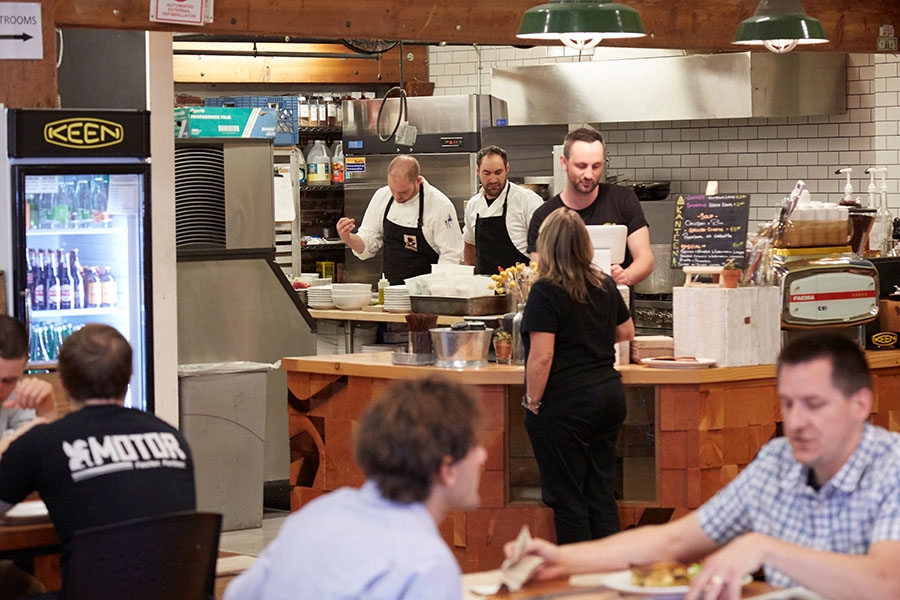Corporate food service reaches out to foodies.
“Tell her about the Mexican Caesar salad!”
“Yeah, and don’t forget the burrito bar!”
Things got exciting while interviewing David Tankersley, executive chef of St. Charles Hospital in Bend, over speakerphone. Employees within earshot couldn’t help but chime in with their favorite menu choices from the hospital’s cafeteria. While hospital food that engenders such passion seems newsworthy enough, what is happening at St. Charles is being repeated in corporate cafeterias around the state. Organizations are upping their cafeteria game, offering scratch-made, locally sourced, high-quality choices to their employees often at subsidized prices.
It’s a perk that benefits everyone. Well-fed workers are happy workers, and employees who get away from their desk are more creative and innovative, Kimberly Elsbach, a professor at the University of California, Davis, graduate school of management, told NPR. Unfortunately, fewer than one in five people take that much-needed break, according to a survey by workplace consulting group Right Management.
Corporate cafeterias are a top-down way to endorse the idea of a midday respite. Subsidizing prices further encourages employees to partake. But while businesses may lose money on their cafeterias, they do get something out of the deal: the chance to serve workers a taste of corporate values while extending their brand.
Keen’s cafeteria does all of that. The outdoor footwear manufacturer believes heavily in protecting the environment, so much so that only one dumpster of construction waste was hauled away after remodeling their five-story Pearl District office three years ago. The ground floor, visible to shoppers in the neighboring showroom, gleams with recycled wood. And if the casual seating groups scattered throughout the space give the impression of a rustic living room, then the Keen Kanteen is the kitchen.
Reducing waste was the primary driver in creating the Keen Kanteen last year, says Erica Waterman, food and beverage manager. “People were bringing take-out in plastic clamshells … and catered events were generating all kinds of waste.” A complicated recycling system (large barrels that sort garbage into 12 different categories) wasn’t enough.
Keen hired Waterman and her husband, chef Ben Waterman, formerly of Olympia Provisions, to create a full-service food program. They serve breakfast, lunch and snacks to the 215-person office, along with catering meetings and events. True to their green commitment, the Kanteen was built with reclaimed materials and stocked with repurposed pots, pans and smallware. Even the oven is secondhand. Since opening, the company reports that waste has been reduced “significantly.” Keen extends the service to their Swan Island factory workers with a weekly free lunch. Keen would not reveal how much they spend on the service.
“Offering food reflects our corporate culture,” says Ashley Williams, director of international marketing at Keen. Employees still take advantage of the many dining options just steps from their Pearl District door. Could the Kanteen be a sneaky way of keeping people in the building during lunch? “No!” insists Williams. “We wanted to provide access to healthy, affordable food. This is an opportunity.”
At Chris King Precision Components, designers and manufacturers of high-end bicycle parts, the cafeteria is also about brand, but on a very personal level. Owner Chris King’s passion for cycling, food and coffee are on full display in the Industrial Northwest factory’s kitchen.
“CK’s love of great food and coffee drove the ethos,” says Brandon Elliott, the company’s communications specialist. When the 30-year-old company moved to Portland in 2003, King included a 2,200-square-foot dining space, a full-sizedcommercial kitchen and a professional grade espresso machine from Seattle’s Synesso. Chef Chris DiMinno plans meals Monday through Thursday, while a guest chef works on Friday.

Elliott reports that 75% to 80% of the company’s 125 employees eat lunch at the cafeteria every day, while half get breakfast. Two kinds of site-baked snacks are also available. While Elliott wouldn’t comment on whether the cafeteria loses money, the prices are clearly subsidized. “The most expensive meal tops out at $5.75,” he says. Elliott also chose not to reveal costs.
While bringing food-service operations in-house remains rare, plenty of other companies offer cafeterias through a partner. Mentor Graphics, Yahoo, Daimler Trucks and Cambia Health Solutions are just a few of the Oregon companies that hire Palo Alto, Calif.-based Bon Appétit Management Company to run their corporate cafes. Some operations are subsidized; others operate as a true profit-and-loss business. All of them stress quality. “Everything is scratch made,” says Tonya Flashey, regional marketing director. Each executive chef writes their own menu, with a set percentage of the offerings coming from local, farm-to-fork vendors.
Bon Appétit stresses a food philosophy — sustainable sourcing, no antibiotics, humanely raised meat and eggs, rights for farm workers — that is in line with many Oregonians’ dietary preferences. This makes choosing a cafe meal that much easier. Other companies go further. Chris King further incentivizes meals with per-mile discounts to employees who cycle to work. Elliott, who commutes 12 miles from Beaverton, gets a $3.50 discount. Those closer in get a little less. Good thing as the food offerings, while healthy and fresh, are calorie dense. “The running joke is everyone gains weight when they start working here,” jokes Elliott.
Unlike Keen, employees at Chris King have limited food choices within reach: Subway, a taproom and a Mexican food truck that rolls through the industrial park daily. Still, management sees the cafeteria less as a perk — “we don’t pitch it during interviews,” says Elliott — and more as part of the culture.
The service is so ingrained that a recent shortage nearly started a riot. “We ran out of coffee for two hours, and there was almost a total nuclear meltdown,” Elliott remembers. Luckily, the Stumptown truck came a little early.
Good food (and coffee) certainly makes people happy. Keeping them healthy is part of St. Charles’s food-service mission. “It’s a whole-body approach to health care where food is medicine,” says Tankersley. This philosophy allows Tankersley to buy more expensive, leaner cuts of meat, locally source proteins and produce and make 75% to 80% of the offerings from scratch. Prices are “reasonable,” he says. A full meal costs about $6. Employees and patients enjoy the food so much that the hospital publishes recipes online.
Employees can’t deny the convenience of on-site food — especially if it’s cheaper than restaurants. With breakfast, lunch and snacks taken care of, there’s one less thing for frazzled workers to worry about. They can even take food home to their families if they want. “We have a pantry program where employees can order entree-style meals to go if they can’t make it to the grocery store,” says Keen’s Waterman. Chris King’s Elliott reports taking cookies and muffins home for his kids.
Clearly Oregon’s ubiquitous foodie culture has moved into the corporate cafeteria. They may be a necessity in remote locations, convenient for organizations with short lunch breaks or just another great choice in a neighborhood filled with restaurants, but providing employees with food is a smart business move. Subsidizing meals may be too. The return on investment “is higher participation, which can yield increased productivity,” argued Anthony Morro, principal of the consulting firm Food Industry Solutions, in a recent blog post. “If you can get even a 1% to 2% improvement, you will begin to reap the rewards of a happier, safer and more productive work force.” Maybe more businesses should offer to pick up the check.



